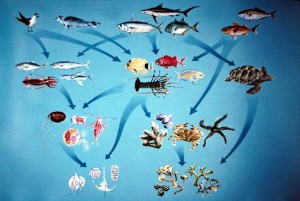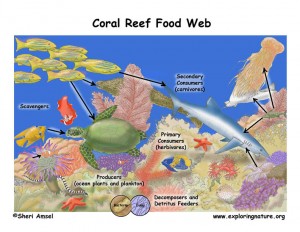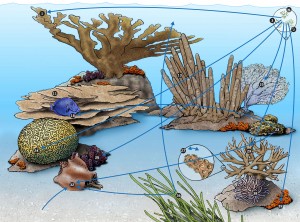 I have a bio-sphere, a small glass orb that I purchased from Amazon. Within it, there is a bio-pellet substrate bottom, marine water, a tiny clump of macro-algae and seven tiny marine shrimp. The entire ball is totally sealed, and the minute ecosystem within is said to last a minimum of two-years. The instructions for caring for the bio-sphere are minimal. Keep it out of constant direct light, but provide enough light for algae to grow, and keep it at room temperature. It’s fascinating to me, that within the nearly 12 months I’ve owned the bio-sphere, nothing within has changed. The tiny shrimp are thriving, the patch of algae remains the same size, and day after day it’s business as usual in the tiny sphere, which rests on a shelf in my living room. I could go throw the host of complex interactions taking place within the little sphere, that allow it to remain sealed from the outside world and still flourish. Then I could write and write how these same systems apply to the health of our aquariums. In reality it boils down to one thing, the food chain.
I have a bio-sphere, a small glass orb that I purchased from Amazon. Within it, there is a bio-pellet substrate bottom, marine water, a tiny clump of macro-algae and seven tiny marine shrimp. The entire ball is totally sealed, and the minute ecosystem within is said to last a minimum of two-years. The instructions for caring for the bio-sphere are minimal. Keep it out of constant direct light, but provide enough light for algae to grow, and keep it at room temperature. It’s fascinating to me, that within the nearly 12 months I’ve owned the bio-sphere, nothing within has changed. The tiny shrimp are thriving, the patch of algae remains the same size, and day after day it’s business as usual in the tiny sphere, which rests on a shelf in my living room. I could go throw the host of complex interactions taking place within the little sphere, that allow it to remain sealed from the outside world and still flourish. Then I could write and write how these same systems apply to the health of our aquariums. In reality it boils down to one thing, the food chain.
We all know the basics of a food chain. Often though, we don’t apply knowledge of marine food chains to our aquariums. These systems complete an entire cycle of waste assimilation and animal nutrition. They are vital to every ecosystem on Earth, including the one within your aquarium.
The role of microbes:
 Within each drop of your aquarium’s water, bacteria and plankton exists that form the base of your tank’s food chain. The oxygen and biomass they are creating are the heartbeat of your tank’s ability to sustain marine life. Algae and phytoplankton take in sunlight, carbon and other nutrients, creating oxygen and food for other organisms. Microbes at the other end of this spectrum are breaking down fish and animal waste, even decomposing dead animals, turning them into nutrients that can then be re-used by phytoplankton. It’s the very basic foundation on which your water’s quality is built.
Within each drop of your aquarium’s water, bacteria and plankton exists that form the base of your tank’s food chain. The oxygen and biomass they are creating are the heartbeat of your tank’s ability to sustain marine life. Algae and phytoplankton take in sunlight, carbon and other nutrients, creating oxygen and food for other organisms. Microbes at the other end of this spectrum are breaking down fish and animal waste, even decomposing dead animals, turning them into nutrients that can then be re-used by phytoplankton. It’s the very basic foundation on which your water’s quality is built.
Beginning and end:
Marine microbes mark the beginning and end of the food chain. They generate nutrients for all life at the beginning, and break down decomposing and decaying matter to be re-used at the end. It is estimated that the mass of all the microbes in the world’s oceans is about the weight of 240 billion African Elephants. It’s safe to say, depending on your aquarium’s size, that the biomass within your tank is quite considerable.
Various producers:
 We decide an animal’s trophic level, based on how many steps away it is from a primary producer. To help understand just what trophic level each of the animals within our aquariums represents, look over the following.
We decide an animal’s trophic level, based on how many steps away it is from a primary producer. To help understand just what trophic level each of the animals within our aquariums represents, look over the following.
- Primary producers/autotrophs: microbes such as plankton and algae
- Primary consumers/heterotrophs: animals that consume primary producers, such as mussels, oysters, krill or copepods/shrimp/etc.
- Secondary consumers/heterotrophs: animals that eat primary consumers, such as humpback whales, lobsters, sea stars, various fish species
- Tertiary consumer/heterotrophs: animals that eat secondary consumers, such as dolphins and sharks, along with various other fish species
- apex predator/heterotrophs: animals with no direct predator, such as sharks and dolphins
- Decomposer/detritiovers: animals that break down waste and dead animals, releasing it as energy and nutrients into the ecosystem.
Human beings like to picture ourselves at the food chain’s top, which depending on how you look at it is incorrect. Since eventually we all will be fertilizing daisies someday, bacteria, fungus and other minute organisms may have us beat.
Role in our aquariums:
 Now this description is based loosely and broadly on oceanic food chains. To create an accurate picture of a reef aquarium’s food chain, you must look at its inhabitants. By doing this, we can create a picture of our aquatic ecosystem and make informed decisions on how to enhance it. It also helps us to realize that to enhance it we may need to remove organisms, or change the type of organisms we are keeping. A food chain (and thus ecosystem) functions best when it’s in balance. Too much of one type of organism and too little of another, throws things off kilter and can potentially give an unwanted organism an advantage to thrive.
Now this description is based loosely and broadly on oceanic food chains. To create an accurate picture of a reef aquarium’s food chain, you must look at its inhabitants. By doing this, we can create a picture of our aquatic ecosystem and make informed decisions on how to enhance it. It also helps us to realize that to enhance it we may need to remove organisms, or change the type of organisms we are keeping. A food chain (and thus ecosystem) functions best when it’s in balance. Too much of one type of organism and too little of another, throws things off kilter and can potentially give an unwanted organism an advantage to thrive.
Example captive reef food chain:
I will use my own 120 gallon reef tank as an example.
- Primary producers: these are microbes (aerobic bacteria, anaerobic bacteria, acellular algae, etc) within live rock, filter bay but primarily located in the zeovit reactor which feeds the tank. They also exist as microscopic particles of algae which photosynthesize releasing oxygen and nutrients to other life forms within the tank. To keep them healthy and assimilating nutrients, they are offered a concentrated carbon food source (Zeobak) twice a week. This is likely also made up various marine viruses, which have both positive and negative effects on primary producer populations. Since at this time, most private aquarists lack the tools or skills to measure virus/bacterial counts within their aquariums, we usually see viral/bacterial interactions in mass bacteria die-offs, resulting in nitrate/phosphate spikes, or cyanobacteria outbreaks. Since corals house zooanthaellae algae, which photosynthesizes and produces nutrients while creating oxygen, in a roundabout way they play the role of primary producer.
- Primary consumers: these are small organisms such as copepods which consume primary producers, literally eating biofilm from live rock and filtration media. Since many corals consume some primary producers (bacteria released from zoevit reactor, etc) they also fall into the role of primary consumers. Peppermint shrimp, hermit crabs and other invertebrates in the tank also consume some primary producers, and thus serve a role as primary consumers.
- Secondary consumers: Since my tank houses a candy basslet and fat head anthias, these two species represent secondary consumers in the tank ecosystem, as they feed off copepods and other invertebrates which are primary consumers. Various invertebrate species, like the fire shrimp within the tank consume primary consumers, and are thus secondary consumers. Any coral species that feeds off a primary consumer plays the role of primary producer, primary and secondary consumer.
- Tertiary consumer: My tank is home to one white tailed surgeonfish and 2 clownfish pairs, all of which feed on secondary consumers that are fed to the tank in the form of Mysis shrimp, squid and other frozen food mixtures. The other fish eat this as well, and play the role of both secondary and tertiary consumers, as they eat a mix of both food types. The same can be said about various shrimp and other animals.
- apex predator: In our tanks, there may be several animals that can be considered apex predators on the tank’s food chain. Any fish, invertebrate or other animal that has no predator could fit this class. Reality is though, that it is unlikely that any of our tank’s animals are truly apex predators within their ecosystem. Disease causing micro-organisms can strike any of our tank’s inhabitants at any moment, meaning danger is always looming on the horizon, even if a direct predator is not always present. A tank that is home to an apex predator within its captive ecosystem is doomed to fail, as this would mean that it’s feeding off its tank mates.
- Decomposer: There is a wide variety of hermit crabs, sea cucumbers and micro-fauna within my aquarium which decompose waste and release nutrients to be used at the food chain’s beginning.
Applications for aquarists:
 By creating a food chain breakdown of your reef tank, you can guide yourself in making stocking decisions, or deciding if you have too much of one animal. Perhaps an aquarium is overstocked with secondary consumers, or lacks a good population of primary consumers. There should be balance along the entire area, paying careful attention to how you are cultivating and maintaining microbes in your tank. Any aquarium that relies solely on live rock, as a way to cultivate a population of microbes, may want to consider methods that focus solely on microbe populations: zeolite, bio-pellets, refugiums, etc.
By creating a food chain breakdown of your reef tank, you can guide yourself in making stocking decisions, or deciding if you have too much of one animal. Perhaps an aquarium is overstocked with secondary consumers, or lacks a good population of primary consumers. There should be balance along the entire area, paying careful attention to how you are cultivating and maintaining microbes in your tank. Any aquarium that relies solely on live rock, as a way to cultivate a population of microbes, may want to consider methods that focus solely on microbe populations: zeolite, bio-pellets, refugiums, etc.









Hey Jeremy – I am doing research for a class assignment requiring me to make a sealed freshwater aquarium. I will be given a 1.5 gallon plastic shoebox, tank gravel, and dechlorinated water. I have to supply the living organisms. This ecosystem has to have 5 trophic levels that stay alive for 8 weeks. Any advice you can give me would be great. I am planning to get the fish at our pet store. Thanks, Luke